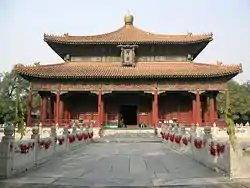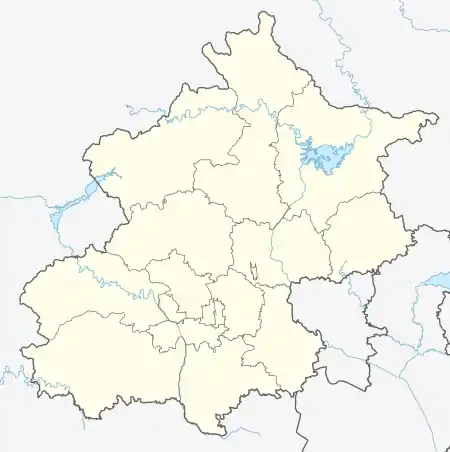Andingmen Subdistrict
安定门街道 | |
|---|---|
 The Imperial Academy within the subdistrict, 2004 | |
.png.webp) Location of Andingmen Subdistrict within Dongcheng District | |
 Andingmen Subdistrict  Andingmen Subdistrict | |
| Coordinates: 39°56′48″N 116°24′25″E / 39.9468°N 116.4070°E | |
| Country | China |
| Municipality | Beijing |
| District | Dongcheng |
| Village-level Division | 9 communities |
| Area | |
| • Total | 1.74 km2 (0.67 sq mi) |
| Population (2020) | |
| • Total | 32,172 |
| • Density | 18,000/km2 (48,000/sq mi) |
| Time zone | UTC+8 (China Standard) |
| Postal code | 100007 |
| Area code | 010 |
Andingmen Subdistrict (Chinese: 安定门街道Chinese: 安定门街道; pinyin: āndìngmén jiēdào) is a subdistrict in the northwestern part of Dongcheng District, Beijing, China. It contains 9 communities, covers 1.74 square kilometers of land, and has a population of 32,172 by the year 2020.[1]
This subdistrict was named after Andingmen (lit. 'Gate of Stability'), a gate of the Beijing city wall that once stood in this area.
History
| Time | Status |
|---|---|
| 1912 | Part of the 3rd and 5th Inner Districts |
| 1949 | Part of Dongcheng District. The following subdistricts were established:
|
| 1955 | Merged into 5 subdistricts: Baochao, Cheniandian, Yongkang, Xiaojingchang and Toutiao. On December of the same year, the latter two were merged into others |
| 1958 | All the subdistricts were combined into Andingmen subdistrict |
| 1960 | transformed into a commune |
| 1990 | Restored as a subdistrict |
Administrative Division
As of 2021, there are 9 communities in Andingmen:[3]
| Administrative Division Code | Community Name in English | Community Name in Simplified Chinese |
|---|---|---|
| 110101004001 | Jiaobei Toutiao | 交北头条 |
| 110101004002 | Beiluoguxiang | 北锣鼓巷 |
| 110101004003 | Guozijian | 国子监 |
| 110101004004 | Zhonglouwan | 钟楼湾 |
| 110101004005 | Baochaonan | 宝钞南 |
| 110101004006 | Wudaoying | 五道营 |
| 110101004009 | Fensiting | 分司厅 |
| 110101004011 | Guowang | 国旺 |
| 110101004012 | Huayuan | 花园 |
Famous Sites
See also
References
- ↑ "China: Bĕijīng Municipal Province". CityPopulation.de. Citing: China National Bureau of Statistics (web), Bureaus of Statistics in Beijing (web). Retrieved 30 September 2020.
- ↑ Zhong hua ren min gong he guo zheng qu da dian. Bei jing shi juan. Li li guo, Li wan jun, Wu shi min, 李立国., 李万钧., 吴世民. Bei jing: Zhong guo she hui chu ban she. 2013. ISBN 978-7-5087-4058-4. OCLC 910451741.
{{cite book}}: CS1 maint: others (link) - ↑ "2021年统计用区划代码和城乡划分代码". www.stats.gov.cn. Retrieved 2022-09-17.
This article is issued from Wikipedia. The text is licensed under Creative Commons - Attribution - Sharealike. Additional terms may apply for the media files.